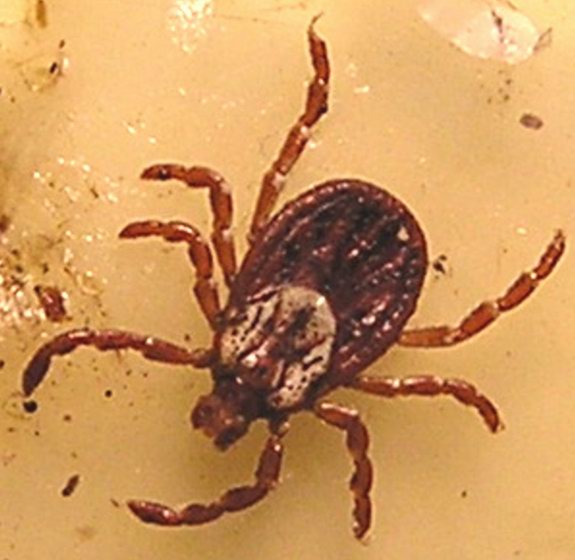|
Common Name: Wood Tick, American Dog Tick (tick is of Teutonic origin and derives from the word ziege meaning goat, presumably the first noted host) Scientific Name: Dermacentor variabilis Family: Ixodidae (hard ticks) The wood tick is among the most accomplished of animal parasites, attaching itself to mammals passing through the woods for its blood meal. As it is 3-4 mm in size, it is fairly easy to see on exposed clothing or skin and can be removed before it feeds. Potpourri: The life cycle of the wood tick is dependent entirely on the blood of its mammal hosts. When a tick egg hatches, the six-legged larva climb up on blades of grass to catch the next mammal, which is usually a mouse or vole. After the blood meal, the larva drops off to molt into an eight-legged nymph, which repeats the process to molt into an adult. Adults repeat the process on larger hosts such as deer or humans. The life cycle is complete when the female adults drop off to lay eggs before dying. Wood ticks are vectors for diseases including Rocky Mountain spotted fever, a zoonosis, or an animal disease that can be transmitted to humans. R. rickettsii, the organism causing the fever, is infectious to ticks, which transmit it to humans with their saliva while feeding. The wood tick has also been found to carry the Lyme disease bacteria, though there have been no known cases of its being transmitted to humans. The tick's stimuli for the parasitic behavior are light, the odor of butyric acid given off by mammals, and the body heat of the host animal. Light stimulates the tick to ascend to the end of a blade of grass to await a passing host. When a butyric acid emitting mammal approaches, the tick releases its grip to drop onto the host. The warmth stimulates the insertion of the proboscis to begin sucking whatever fluid is contained therein. The taste of blood and mammalian characteristics are not meaningful to the tick. |
